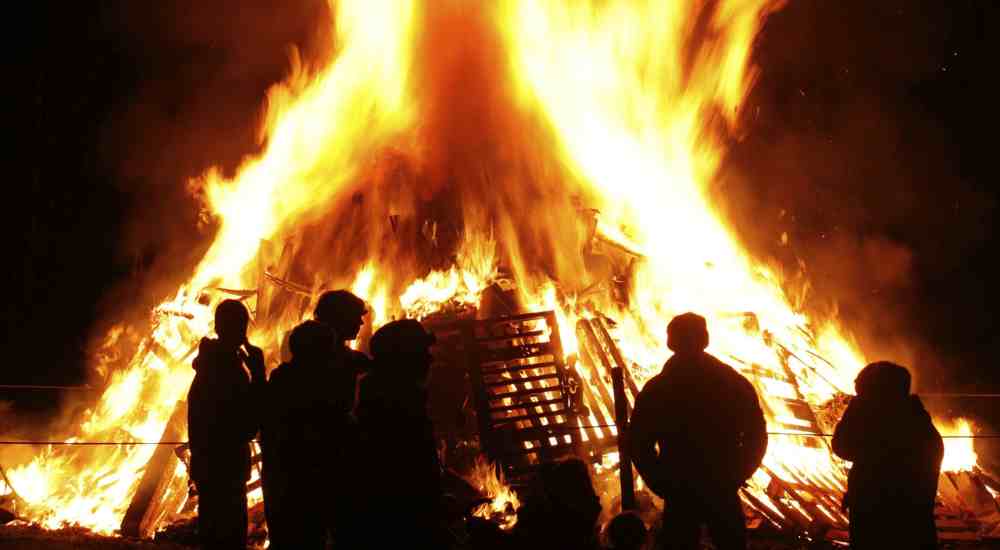Bonfire Night, also known as Guy Fawkes Night, holds a special place in the hearts of the United Kingdom. This annual event, celebrated every November 5, ignites the sky with fireworks and the night with the warm glow of bonfires. But it’s not just a festive occasion; it’s a celebration with a deep historical significance.
On the surface, Bonfire Night may seem like a night of revelry, but it is rooted in the failed 17th-century attempt to blow up the Parliament and assassinate King James I. This historical backdrop provides a fascinating context for the modern-day festivities. As the famous nursery rhyme goes:
“Remember, remember November 5,
Gunpowder treason and plot.
We see no reason
Why gunpowder treason
Should ever be forgotten.”
In this article, we will delve into the captivating History of Bonfire Night, explore how it is celebrated, and uncover the unique traditions associated with it. So, let’s embark on a journey through time and celebration to understand the magic of Bonfire Night.
History of Bonfire Night
Bonfire Night is a tapestry woven from the threads of a dramatic chapter in British History—the infamous Gunpowder Plot of 1605. This historical context sets the stage for the vibrant celebration we know today.
The Gunpowder Plot of 1605
In the early 17th century, England was mired in a complex religious and political struggle. The Church of England, headed by King James I, was rapidly expanding its influence, leading to growing intolerance against Catholics. The plot known as the “Gunpowder Plot” was conceived out of an uncontrollable anger by Catholics who believed that Catholicism could only be reinstated through armed struggle.

Key Figures and Their Motivations
Guy Fawkes: Guy Fawkes, a devout Catholic, emerged as a central figure in the conspiracy. His fervent belief in the restoration of Catholicism drove him to be a key player in the plot. His role was to execute the dangerous task of blowing up the Palace of Westminster on the opening day of Parliament, with the king himself in attendance.
Robert Catesby: Another ardent Catholic, Catesby was the mastermind behind the plot. He, too, believed in the need for armed struggle to defend the Catholic faith.
The Failed Plot and Discovery
The plot was brought to the brink of success but was ultimately thwarted. An unknown member of the conspiracy, having second thoughts, sent a letter to a member of Parliament, warning him to stay away from the Parliament building on the fateful night. This letter was forwarded to the King, saving his life and the fate of Parliament. A brief struggle followed, leading to the capture of Fawkes and his group.
On the very night of the failed plot, citizens all over London celebrated by lighting bonfires, marking the end of this dangerous conspiracy. Fawkes and his co-conspirators were convicted of treason, a crime that condemned them to a slow, torturous death of being “drawn and quartered.” However, in a last act of defiance, Guy Fawkes jumped to his death seconds before his execution.
The Birth of Bonfire Night
In the aftermath of the failed coup, Parliament declared November 5 as a “day of thanksgiving,” beginning in 1606. This tradition has continued ever since, evolving into the grand Bonfire Night celebrations we know today.
How Bonfire Night is Celebrated
Bonfire Night is a beloved tradition in the United Kingdom, and the way it’s celebrated showcases the diversity and enthusiasm of the British people. It’s a night that brings communities together in a blaze of fiery spectacle and historical remembrance.
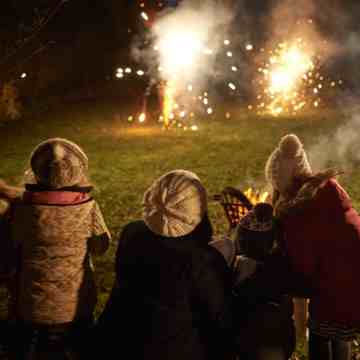
Fireworks Displays: One of the most iconic aspects of Bonfire Night is the dazzling fireworks displays that light up the night sky. Cities and towns across the UK organize breathtaking pyrotechnic shows that draw thousands of spectators. These displays are a visual feast, with fireworks of all colors, shapes, and sizes bursting into the night, creating a kaleidoscope of light.
Bonfires: The heart of Bonfire Night lies in the bonfires themselves. Communities build massive bonfires, often at central locations, and gather around them. The roaring flames and crackling wood add a primal, communal touch to the celebration. People huddle around these fires, enjoying the warmth and the spectacle of the burning effigy of Guy Fawkes.
Traditional Activities
- Effigy Burning: A quirky tradition involves creating and burning an effigy of Guy Fawkes atop the bonfire. This practice serves as a symbolic retribution for the Gunpowder Plot and has become a whimsical yet essential part of Bonfire Night.
- Food and Drink: Traditional dishes like bangers and mash are served, adding to the warmth and camaraderie of the evening. Warm drinks like mulled wine or hot chocolate are also popular choices to combat the chilly November air.
- Reading Up on the Gunpowder Plot: For those who appreciate the historical context, Bonfire Night is an ideal time to delve into the History of the Gunpowder Plot. Many Londoners knew that the King’s life had been saved, and this knowledge is what sparked the original bonfire celebration back in 1605.
Bonfire Night Timeline
The History of Bonfire Night is a rich tapestry of events that have unfolded over the centuries, with a core narrative anchored in the infamous Gunpowder Plot of 1605. Here, we take a journey through time to uncover the key milestones in the development of Bonfire Night.
The Gunpowder Plot Fails (1605)
The story of Bonfire Night finds its roots in the Gunpowder Plot, which unfolded in the year 1605. A group of conspirators, including Guy Fawkes and Robert Catesby, hatched a daring plan to blow up the Parliament building and assassinate King James I. However, their plot was discovered in the eleventh hour when an anonymous member of the conspiracy sent a letter to a member of Parliament, warning him to stay away from the Parliament building that night. This tip-off ultimately saved the king’s life and Parliament.
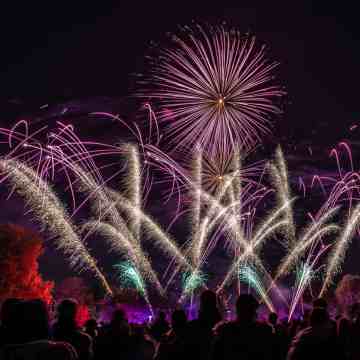
England Proclaims an Annual Day of Thanksgiving (1606)
Just one year after the failed Gunpowder Plot, the English Parliament passed the Observance of the “5th November Act” in 1606. This act proclaimed November 5 as a day of thanksgiving. The intention was to commemorate the king and Parliament in the wake of the deadly assassination attempt. This was the beginning of the tradition of celebrating Bonfire Night in the UK.
The First Big Bonfire Night Celebration Occurs (November 5, 1607)
The spirit of Bonfire Night found its first expression in 1607 when the city of Canterbury celebrated the date with a grand spectacle. They ignited over 100 pounds of gunpowder and 14 pounds of matches, adding food and drink to the festivities in later years.
Lewes Famous Celebrates Bonfire Night (1850)
Lewes, a town in England, became famous for its extravagant Bonfire Night celebrations. However, the festivities sometimes resembled a riot, which led to a temporary ban in 1850. Fortunately, the ban was lifted, and the tradition continued peacefully.
Bonfire Night Activities
As Bonfire Night approaches, you might be wondering how to make the most of this historic and exciting occasion. Here are some suggestions on how you can celebrate Bonfire Night and fully immerse yourself in the festivities:
1. Light Your Own Bonfire
Lighting your own bonfire can be an exhilarating and communal way to celebrate Bonfire Night. Gather your friends and family, and follow these safety tips to ensure a fun and secure experience:
- Choose a safe location away from flammable materials and structures.
- Keep a bucket of water or a hose nearby for emergencies.
- Supervise the bonfire at all times, especially if children are present.
- Use only dry, seasoned wood and avoid using accelerants like gasoline.
- Ensure the fire is fully extinguished before leaving.
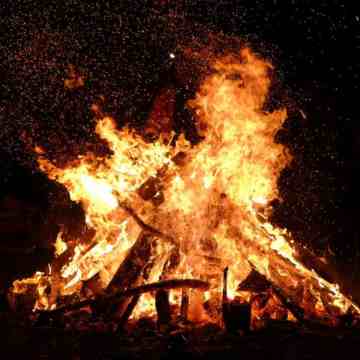
2. Prepare Traditional Dishes like Bangers and Mash
Traditional British cuisine plays a significant role in Bonfire Night celebrations. One classic dish is “bangers and mash,” which consists of sausages and mashed potatoes. Preparing this comfort food adds a delicious and heartwarming element to your celebration. You can even cook the sausages over your bonfire if you want to embrace the traditional spirit of the event. Don’t forget the gravy!
3. Read Up on the Gunpowder Plot
To fully connect with the historical context of Bonfire Night, take some time to learn about the Gunpowder Plot. Understanding the motivations, key figures, and the events leading up to the failed plot will enhance your appreciation of the occasion. It’s an opportunity to reflect on the historical significance of the night while enjoying the modern celebrations.
Unique Bonfire-Friendly Dishes
While traditional bangers and mash are a staple of Bonfire Night, adding a unique twist to your menu can elevate your celebration. Here are some exciting recipes and ideas for dishes that you can cook over the bonfire. Please remember to prioritize safety when cooking over an open flame:
1. Cinnamon Sugar Donuts
Recipe: Prepare biscuit dough in advance, then flatten small portions and shape them into doughnuts. Cook them over the bonfire using a long stick or skewer. Afterwards, roll them in a mixture of cinnamon and sugar. Be cautious with the hot oil when cooking.
Safety Tip: Maintain a safe distance from the bonfire when handling hot oil to prevent accidents.
2. Chocolate Eclairs
Recipe: Wrap crescent roll dough around a stick and cook it over the fire until golden brown. Remove the dough from the stick and fill it with chocolate frosting or pudding.
Safety Tip: Use heat-resistant gloves or tongs to handle the hot dough and avoid touching it directly.
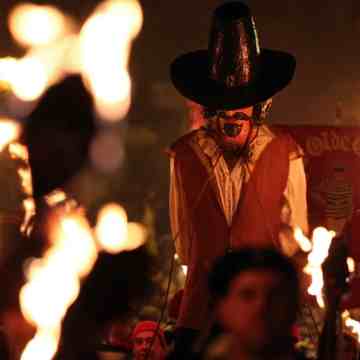
3. Banana S’mores
Recipe: Slice a banana lengthwise, stuff it with mini marshmallows and chocolate chips, then wrap it in foil. Heat the banana over the fire until the marshmallows and chocolate melt.
Safety Tip: Be cautious when unwrapping the foil, as steam may escape.
4. Breakfast Sandwiches
Recipe: Cook biscuit dough and an egg using muffin tins over the bonfire. Once both are heated, assemble your sandwich with cheese, onion, and season with salt and pepper.
Safety Tip: Use long utensils or sticks to handle the hot ingredients when assembling the sandwich.
Why We Love Bonfire Night
Bonfire Night holds a cherished place in the hearts of the British people, and the reasons behind this affection are both deeply rooted in History and inspired by the unique qualities of the event.
Cultural and Historical Significance
Bonfire Night offers a captivating window into the pages of British History. Its roots are entwined with the turbulent times of the early 17th century, marked by the Gunpowder Plot of 1605. This story of intrigue, betrayal, and political assassination rivals the most dramatic narratives found on our favorite streaming platforms. It reveals the state of the nation at the time and the tension between Catholics and Protestants, which significantly shaped Britain’s History.
The celebration serves as a historical mirror, reflecting the struggles and triumphs of the past. The symbolic effigy burning of Guy Fawkes on the bonfire embodies the collective memory of a nation and serves as a unique form of historical retribution, all while fostering unity and reflection.
Unique Qualities
A Unique Experience: Bonfire Night is an event that anyone can enjoy. It is a fascinating fusion of History and spectacle, a combination not easily found in other celebrations. The grand fireworks displays, festivals, and bonfire events offer something for everyone, ensuring a memorable experience.
Keeping History Alive: Bonfire Night helps keep British History alive, reminding us of the political and religious struggles that have shaped the country. It is not merely a historical reenactment; it’s a living, breathing connection to the past.
Inclusivity: People of all ages are drawn to Bonfire Night. It’s a multi-generational event where grandparents, parents, and children can come together to enjoy the festivities. The tradition of children walking the streets with a Guy Fawkes dummy, asking for money to buy fireworks, remains a charming element of the night, even if they can no longer purchase fireworks themselves.
Bonfire Night in Other Countries
While Bonfire Night is an iconic celebration in the United Kingdom, similar events with their own unique customs and traditions can be found in various other countries and regions around the world. Let’s explore the global diversity of bonfire-related celebrations:
1. Guy Fawkes Night in Commonwealth Countries
Several Commonwealth countries, including New Zealand, Canada, and South Africa, celebrate Guy Fawkes Night on November 5. The traditions are often similar to those in the UK, with fireworks, bonfires, and effigy burnings.
2. Northern Ireland’s Eleventh Night
In Northern Ireland, the Eleventh Night, celebrated on July 11, has its roots in sectarian History. It marks the Battle of the Boyne of 1690, where Protestant King William of Orange defeated Catholic King James II. Communities build towering bonfires, and there are fireworks and parades.
3. Saint John’s Eve in Spain and Portugal
Saint John’s Eve, celebrated on June 23, is a significant occasion in Spain and northern Portugal. It involves bonfires, fireworks, and various customs, including leaping over the flames and water-related traditions.
4. Walpurgis Night in Scandinavia and Germany
Known as Walpurgis Night, this celebration takes place on April 30 and the night of April 30–May 1. It is marked by bonfires, dancing, and various rituals in countries like Sweden, Finland, Germany, and the Czech Republic. The holiday has both pagan and Christian roots.
5. Sankthansaften in Denmark and Norway
Sankthansaften, celebrated on June 23, is the Scandinavian equivalent of Saint John’s Eve. It involves bonfires, singing, and dancing, often by the water’s edge, as well as the burning of effigies.
6. Bonfire Nights in Ireland
In various parts of Ireland, bonfire nights are held on Saint John’s Eve (June 23), Bealtaine Eve (April 30), and Halloween (October 31). These celebrations often include bonfires, fireworks, and traditional customs.
7. Bonfire Night in Newfoundland and Labrador, Canada
The Canadian province of Newfoundland and Labrador celebrates Bonfire Night on November 5 with bonfires and firework displays. It is officially recognized and celebrated.
Social Impact and Safety
Bonfire Night is a celebration filled with joy, but it is not without its safety concerns and environmental impacts. Addressing these issues is crucial to ensure that the festivities remain both enjoyable and responsible.
Fire Risks and Injuries
One of the most significant safety concerns on Bonfire Night is the risk of fires and related injuries. With the lighting of bonfires and fireworks, there is the potential for accidents. To mitigate these risks:
- Follow safety guidelines when setting up and lighting fireworks.
- Keep a safe distance from the bonfire and supervise it at all times, especially if children are present.
- Avoid using accelerants like gasoline when starting a bonfire.
- Have a bucket of water, a fire extinguisher, or a hose nearby in case of emergencies.
- Ensure that all participants are aware of fire safety measures and the importance of adhering to them.
Environmental Impact
Bonfire Night can also have an environmental impact, particularly when it comes to air quality. The release of pollutants from bonfires and fireworks can contribute to air pollution, with the potential to harm the environment and human health.
To reduce the environmental impact:
- Opt for cleaner-burning fireworks and minimize their use.
- Dispose of waste responsibly and recycle where possible.
- Consider attending organized, public firework displays that are likely to be more environmentally conscious in their planning and execution.
Responsible Celebrations
- Promoting responsible celebrations is essential to ensure the safety and well-being of everyone involved and to protect the environment. This includes:
- Encouraging the use of noiseless or low-noise fireworks to minimize disruption to people, pets, and wildlife.
- Educating participants about the importance of cleaning up after the celebrations and disposing of waste properly.
- Reminding individuals not to release sky lanterns, which can pose fire risks and contribute to litter and harm to wildlife.
Traditional Bonfire Night Food
Traditional Bonfire Night food adds a delicious and comforting layer to the festivities. These dishes have become synonymous with the event, offering a delightful array of flavours and textures that warm both body and soul. Here’s a closer look at some of the quintessential dishes:
1. Toffee Apples
Background: Toffee apples, also known as candy apples, are a sweet treat that encapsulates the essence of Bonfire Night. These glossy, caramel-coated apples are a delightful combination of sweetness and tartness.
Recipe: To make toffee apples, start by melting sugar and golden syrup until it reaches a deep amber colour. Then, dip your apples into the toffee mixture and allow it to harden before enjoying.
2. Treacle Toffee
Background: Treacle toffee, often called “bonfire toffee,” is a rich, dark, and intensely sweet confection that is a true Bonfire Night classic. It’s traditionally made to be hard and can be broken into pieces.
Recipe: To create treacle toffee, you’ll need black treacle, sugar, and butter. Boil these ingredients together until they reach a certain temperature, then pour the mixture into a greased pan to cool. Once set, break it into pieces and savour the rich flavour.
3. Black Peas
Background: Black peas are a savory delicacy that adds balance to the sweet offerings of Bonfire Night. These slow-cooked, seasoned peas have been a staple at many celebrations.
Recipe: To prepare black peas, soak dried peas overnight and then slow-cook them with a mix of spices, often including salt, vinegar, and butter. The long cooking time allows the flavors to meld and intensify.
4. Parkin
Background: Parkin is a hearty, spiced cake that has been associated with Bonfire Night for generations. Its dense and moist texture, along with its warming spices, make it an ideal autumn treat.
Recipe: Parkin typically includes ingredients like oats, treacle or syrup, ginger, and nutmeg. It’s a straightforward cake to make, and its flavours deepen over time, making it a great make-ahead option for your celebration.
5. Jacket Potatoes
Background: Jacket potatoes are a warm and hearty dish that complements the chill of November nights. They are a simple yet satisfying addition to Bonfire Night celebrations.
Recipe: To make jacket potatoes, choose large baking potatoes and bake them in the oven until the skins are crispy and the insides are soft and fluffy. They can be served with various toppings like butter, cheese, sour cream, or beans.
Conclusion
Bonfire Night, or Guy Fawkes Night, is a celebration that holds a unique place in the hearts of the United Kingdom and beyond. It commemorates a moment in History that shaped the nation and has evolved into a vibrant event that unites communities, celebrates History and fills the night sky with dazzling fireworks.
This cherished occasion has been a part of the cultural fabric for centuries, from the historical origins rooted in the Gunpowder Plot to the contemporary celebrations that light up the dark November nights. It’s a night when people of all ages come together to honor the past, enjoy the present, and create cherished memories.
As you prepare for Bonfire Night, remember to embrace the traditions that make it special, whether it’s lighting your own bonfire, savouring traditional dishes, or watching the breathtaking fireworks displays. But alongside the revelry, it’s vital to prioritize safety, both in handling fireworks and ensuring the well-being of all participants.
Furthermore, consider the environmental impact of the celebrations and make choices that minimize harm to the planet. By adopting eco-friendly practices and responsible conduct, we can continue to enjoy this time-honored tradition without compromising our surroundings.
In conclusion, Bonfire Night is more than just fireworks and bonfires. It’s a celebration of History, unity, and the enduring spirit of communities. As you partake in the festivities, take a moment to reflect on the significance of the event and the connections it fosters. Let us celebrate responsibly and in the true spirit of Bonfire Night, embracing the past and kindling the flames of tradition for future generations to enjoy.

